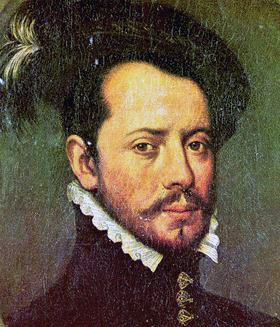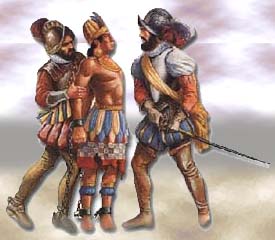 Colonial expansion under the Spanish Empire was initiated by the Spanish conquistadores and developed by the Monarchy of Spain through its administrators and missionaries. The motivations for colonial expansion were trade and the spread of the Christian faith through indigenous conversions. It lasted for over four hundred years, from 1492 to 1898.
Colonial expansion under the Spanish Empire was initiated by the Spanish conquistadores and developed by the Monarchy of Spain through its administrators and missionaries. The motivations for colonial expansion were trade and the spread of the Christian faith through indigenous conversions. It lasted for over four hundred years, from 1492 to 1898.Beginning with the 1492 arrival of Christopher Columbus, over nearly four centuries the Spanish Empire would expand across: most of present day Central America, the Caribbean islands, and Mexico; much of the rest of North America including the Southwestern, Southern coastal, and California Pacific Coast regions of the United States; and though inactive, with claimed territory in present day British Columbia Canada; and U.S. states of Alaska, Washington, and Oregon; and the western half of South America.[1][2][3] In the early 19th century the revolutionary movements resulted in the independence of most Spanish colonies in America, except for Cuba and Puerto Rico, given up in 1898 following the Spanish-American War, together with Guam and the Philippines in the Pacific. Spain's loss of these last territories politically ended Spanish colonization in America. The cultural influences, though, still remain.
 Was a Spanish Conquistador who led an expedition that caused the fall of the Aztec Empire and brought large portions of mainland Mexico under the rule of the King of Castile in the early 16th century
Was a Spanish Conquistador who led an expedition that caused the fall of the Aztec Empire and brought large portions of mainland Mexico under the rule of the King of Castile in the early 16th century Was a Spanish conquistador, conqueror of the Incan Empire, and founder of Lima, the modern-day capital of the Republic of Peru.
Was a Spanish conquistador, conqueror of the Incan Empire, and founder of Lima, the modern-day capital of the Republic of Peru. The Inca Empire, or Inca Empire, was the largest empire in pre-Columbian America. The administrative, political and military center of the empire was located in Cusco in modern-day Peru. The Inca civilization arose from the highlands of Peru sometime in the early 13th century. From 1438 to 1533, the Incas used a variety of methods, from conquest to peaceful assimilation, to incorporate a large portion of western South America, centered on the Andean mountain ranges, including large parts of modern Ecuador, Peru, western and south central Bolivia, northwest Argentina, north and north-central Chile, and southern Colombia into a state comparable to the historical empires of Eurasia.
The Inca Empire, or Inca Empire, was the largest empire in pre-Columbian America. The administrative, political and military center of the empire was located in Cusco in modern-day Peru. The Inca civilization arose from the highlands of Peru sometime in the early 13th century. From 1438 to 1533, the Incas used a variety of methods, from conquest to peaceful assimilation, to incorporate a large portion of western South America, centered on the Andean mountain ranges, including large parts of modern Ecuador, Peru, western and south central Bolivia, northwest Argentina, north and north-central Chile, and southern Colombia into a state comparable to the historical empires of Eurasia.Their last ruler was Atahualpa.


No hay comentarios:
Publicar un comentario